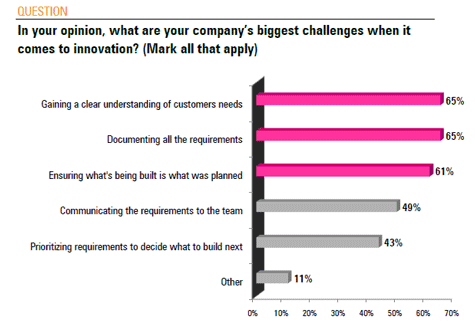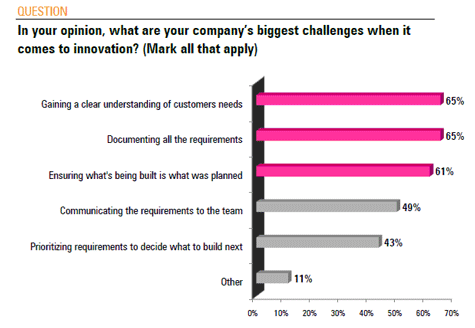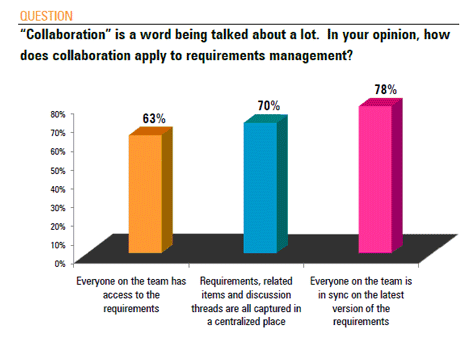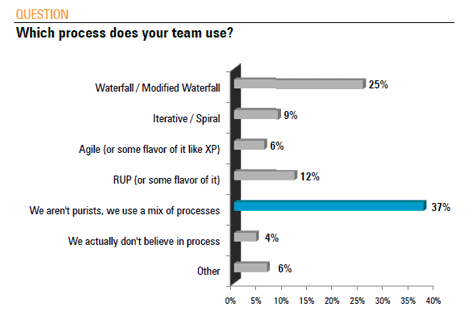
The State of Requirements Management
Goodbye 2009, Hello 2010!
For many organizations, 2009 simply can’t end fast enough. The brutal economy made for a tough year, there’s no denying that. However, taking a moment to reflect on things from a business analyst’s point of view, I believe there are a few bright spots to celebrate. Consider them the signs of hope for a better 2010. In this article, I want to highlight three trends we first saw emerge from The State of Requirements Management Report we published back in June 2008 on the challenges, trends and solutions happening in software product development. In that report we surveyed 200 organizations and explored topics such as:
- What are the biggest challenges in innovation that companies face?
- Is the Agile process over-hyped?
- How does collaboration apply to requirements management?
- What frustrates people more – scope creep, unrealistic expectations or lack of testing?
- Which genre of music is most popular? OK, that one we threw in just for fun.
I never anticipated the kind of response that report would get, with over 18,000 downloads of it since we first published it, but in hindsight I think it struck a chord with people, especially those in the business analyst community, shedding light on some of the challenges we all deal with day in, day out. You can read the full report and compare the results to what you experienced this year. I would be curious to hear your thoughts and experiences. http://www.jamasoftware.com/media/documents/State_of_Requirements_Management_2008_Jama.pdf
As I look back on 2009, the three positive trends I saw emerge which will carry over into 2010 include:
1. Greater Respect and Appreciation for the Business Analyst Role
Understanding what the customers need and documenting all the requirements isn’t easy. In fact, these were the top challenges based on feedback we saw within The State of Requirements Management Report at 65% each.

As it becomes more apparent to executives and senior management that requirements are the building blocks of innovation, the respect for the people whose job it is to manage requirements increases. Can you say “Christmas bonus”? And, I’m not talking fruit cake; give the BAs you love something good this year!
In all seriousness, this heightened appreciation for BAs is also reflective in its being an area of job growth, despite high unemployment rates in other sectors. Essentially, if you have strong business analyst and product management skills, you are in high demand. Feel good about that for a moment, now put down the eggnog and get back to work. You’re only as good as your latest specification, right?
2. Greater Accountability for the Requirements Shared by the Entire Team
Collaboration has been a hot trend in product development for a few years now. But, what does that really mean in terms of results? One of the lesser known benefits of better collaboration is that over time you see an increase in accountability across the entire team for getting the requirements right and building the products to spec. That’s a good thing for everyone. How often before did all the responsibility fall just on the shoulders of the business analyst or product manager to define the set of features and write gorgeous requirements that would be magically understood and implemented flawlessly by all?

Truly collaborative teams embody this shared accountability which raises the bar for everyone involved, whether it’s your job to listen to the customer and capture the requirements or interpret the detailed requirements downstream to code and ensure the functionality is right. When everyone contributes to the development of the requirements, the success rates increase dramatically.
If your team doesn’t embody this characteristic now, you might want to make it a priority in 2010, or hope for a miracle bag of requirements pixie dust from Santa. I think that’s high on the wish list right after the Wii and Twilight stuff.
3. Agile is More of a Mindset than a Development Process.
Man, there was a ton of attention given to Agile again this year. Agile conferences. Agile books. Agile processes du jour. I think I’ve contracted “Agileitis”, the rapidly, contagious disease that can be spread from the “pigs” to the “chickens” in a Scrum daily stand-up meeting… I know there’s a bad Swine flu / Bird flu whopper of a joke in there somewhere.
The key point is, Agile isn’t just a flavor of development process. It’s a core philosophy – a cultural mindset of embracing change, inviting the voice of the customer into your process throughout, and designing workable software that is continuously improving over time. Call them releases, iterations, sprints, milestones – whatever you want. The labels are less important than the outcome of the products you produce. The evolution I saw emerge in 2009, and will continue in 2010, is the concept of a “hybrid” approach where mature companies merge disciplined requirements management practices for proper planning and requirements documentation, with the freedom for developers and testers to adopt more agile, lightweight methods to build and test new releases. It’s the best of both worlds.

I’ve seen many companies be successful with a hybrid process, and one of the reasons it’s more prevalent now is that the tools available today are designed to flex to support whatever process or processes work for your team.
Big picture – the goals are the same – build great products faster, cheaper and with higher quality. My recommended New Year’s Resolution: Adopt whatever mix of processes, people and tools you need to achieve your goals, demand and accept nothing less, and you’ll have a great 2010.
Looking ahead to January – Share Your Voice.
In January, I’ll be conducting the 2010 State of Requirements Management Survey and would love your participation. That way, we can establish an annual benchmark study for our industry on what’s real and what’s hype, and see what others are doing to be more successful managing requirements. So look for that after the holidays.
On a personal note, from my family to yours – I’d like to wish everyone and their families – happy holidays and best wishes for a prosperous new year! See you in 2010.
Don’t forget to leave your comments below
John Simpson is director of customer outreach and marketing at Jama Software. John represents the voice of the customer in Jama’s product strategy and communications. He has over 12 years experience working at software technology companies including Microsoft, WebTrends and Omniture. In his spare time, he chases his three kids around and raises awareness for cancer research in his local community, Portland, OR. You can reach John at http://www.jamasoftware.com or follow him on Twitter at http://www.twitter.com/jamasoftware.